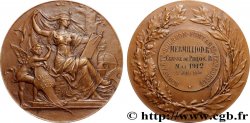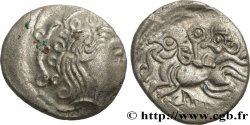fmd_289081 - Essai de 20 francs Turin, en cupro-nickel 1939 Paris VG.-
non disponibile.
Articolo venduto sul nostro negozio (2015)
Prezzo : 3 500.00 €
Articolo venduto sul nostro negozio (2015)
Prezzo : 3 500.00 €
Tipo : Essai de 20 francs Turin, en cupro-nickel
Data: 1939
Nome della officina / città: Paris
Metallo : cupronichel
Diametro : 34,94 mm
Asse di coniazione : 6 h.
Peso : 17,04 g.
Orlo : striée
Grado di rarità : R3
Commenti sullo stato di conservazione:
Exemplaire parfait mais surface terne quoique avec de jolis reflets au droit. Une petite tache noire sur le cou
Diritto
Titolatura diritto : REPUBLIQUE - FRANÇAISE.
Descrittivo diritto : Tête de la République à droite, coiffée d'un bonnet phrygien lauré ; signé P. TURIN sous le buste.
Rovescio
Titolatura rovescio : 20 / FRANCS / 1939 / LIBERTE / EGALITE / FRATERNITE / ESSAI.
Descrittivo rovescio : Entre deux épis de blé verticaux.
Commento
Cet essai n’est pas répertorié dans les principaux ouvrages de référence si ce n’est Gadoury qui indique “épreuve en cupro-nickel”. On notera que le diamètre est, contrairement aux autres essais de la collection Pierre, pratiquement identique au standard émis. Le millésime de cet essai, 1939, est particulièrement intéressant ; la proximité de la guerre a probablement suggéré des essais en métal non précieux, sans comprendre que, durant une guerre moderne, les métaux stratégiques sont aussi des métaux précieux.
This test is not listed in the main reference works except for Gadoury who indicates “cupro-nickel proof”. It should be noted that the diameter is, unlike the other tests in the Pierre collection, practically identical to the issued standard. The vintage of this test, 1939, is particularly interesting; the proximity of the war probably suggested tests in non-precious metal, without understanding that, during a modern war, strategic metals are also precious metals
This test is not listed in the main reference works except for Gadoury who indicates “cupro-nickel proof”. It should be noted that the diameter is, unlike the other tests in the Pierre collection, practically identical to the issued standard. The vintage of this test, 1939, is particularly interesting; the proximity of the war probably suggested tests in non-precious metal, without understanding that, during a modern war, strategic metals are also precious metals








 Segnalare un errore
Segnalare un errore Stampate la pagina
Stampate la pagina Condividi mia selezione
Condividi mia selezione Fai una domanda
Fai una domanda Consegnare / vendere
Consegnare / vendere
 Descrittivo
Descrittivo















